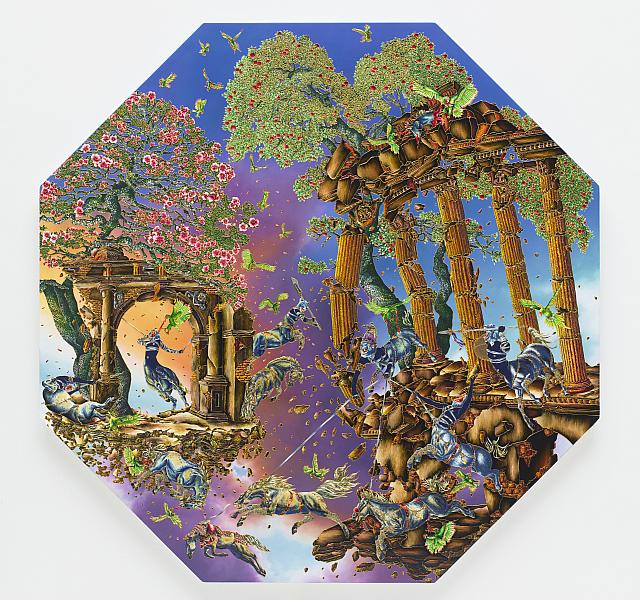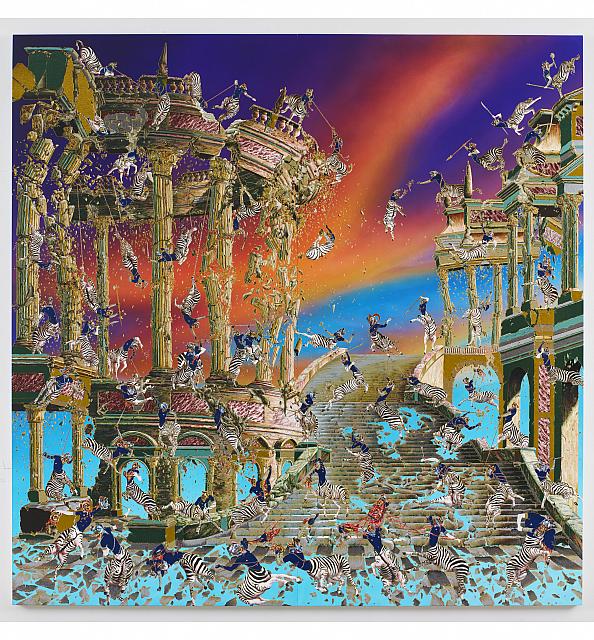Indian artist Raqib Shaw’s monumental exhibition Paradise Lost at Pace Gallery, New York, of large meticulously painted fabulations rendered like an overlay of inlaid mosaic tiles is exhilarating beyond belief. The viewer is drawn at once to its spellbinding craftsmanship and exuberance, and the everlasting lure of decadence. But in fact Shaw delivers quite the opposite. Decay, mayhem and dog-eat-dog aggression combined with the sheer anticlimactic mode of opulence gone awry fill many of his paintings.
Paradise Lost, 2001-13, comprising of twelve 10’ x 60’ panels, is the precursor to the world of doom. Mughal artistry, Indian mythology, and medieval history come together in Shaw’s evocation of John Milton’s epic poem “Paradise Lost.” Here in the garden of innocence, untainted as yet by the ways of the world, a coyote howls ominously at the moon. Dark skies, coniferous forests, and mountainous terrains abundant with the animal kingdom reminiscent of Noah’s Ark and the Panchatantra—Indian animal fables of the 3rd century—slowly give way to daylight, cherry blossoms, and hordes of chirping birds. Shaw proves to be the quintessential raconteur of images as his narrative plays out in languorous splendor along the lengthy canvas. The only human being in the story resembles Hanuman the Indian monkey god from the legendary Ramayana. Yet he is in bondage as he floats from the cherry tree, pointing to forthcoming difficulties. Much like The Garden of Earthly Delight, 2012, filled with bejeweled flowers and dancing peacocks that conjure life before Satan’s treacherous prevarications, Shaw uses the conventional storyteller’s technique of detail and description to enthrall his audience.
Embracing tradition in his flagrant departure from the trajectory of modernism and contemporary art, Shaw’s panoply of strange animals with zebra bodies and bear heads equipped with human mannerisms engage in the annihilation of the world. In Doomsday at Xanadu, 2011-12, Armageddon is nigh. Pillars and grand entrances to opulent empires collapse and unleash a cruel fast paced world of endless destruction. Referencing the explorer Marco Polo’s lavish description of Xanadu, the summer palace of the Mongolian ruler in 1275, with images from ancient Rome, Shaw’s phantasmagoria of a world gone berserk appears plausible. His ability to commingle the past with the present to foretell a realistic future through his make-believe fantasia is the key to his success.

Raqib Shaw, The Disambiguation of the Myth of the Last Shinobi, 2011-2013.
Oil, acrylic, enamel, glitter and rhinestones on Birch wood. 55-3/8 x 55-3/8 in.
In The Disambiguation of the Myth of the Last Shinobi, 2011-12, anxiety pervades beneath the excesses of beauty and overwhelming abundance. A battle fought by the famous Japanese video game ninja Shinobi is the ostensible cause of the ensuing warfare. Delivered in Shaw’s over-the-top profusion of action and wreckage, here too in a bizarre world where everything from the structures to the trees are free-floating and untethered, there is great truth behind the carnage that points to the eventual downfall of our own doing.
If one were to draw a connection between Shaw’s images and the Kenyan collage artist Wangechi Mutu’s strange cyborgian women festooned with rhinestones and glitter, one sees a similar fetish for over-extended imagery. It raises an important question about the new lingua franca of non-western artists who blend techniques, traditions, and inspiration from the east and west to communicate their worldviews. For Shaw as much as for Mutu, their outrageously outlandish landscapes inhabited by mysterious creatures both lure and repel as they have a transformative hold on the viewer. Innovativeness and a new kind of aesthetics marked by a combination of extreme forms of beauty and ugliness is their de facto mode of expression. Endlessly fascinating and interpretable works of art emanate from this new language.
Ultimately, Paradise Lost succeeds in engaging the viewer such that there might be the possibility of hope that arises from decay and decadence, and all may not be lost to an unfulfilled paradise.
By Bansie Vasvani
























